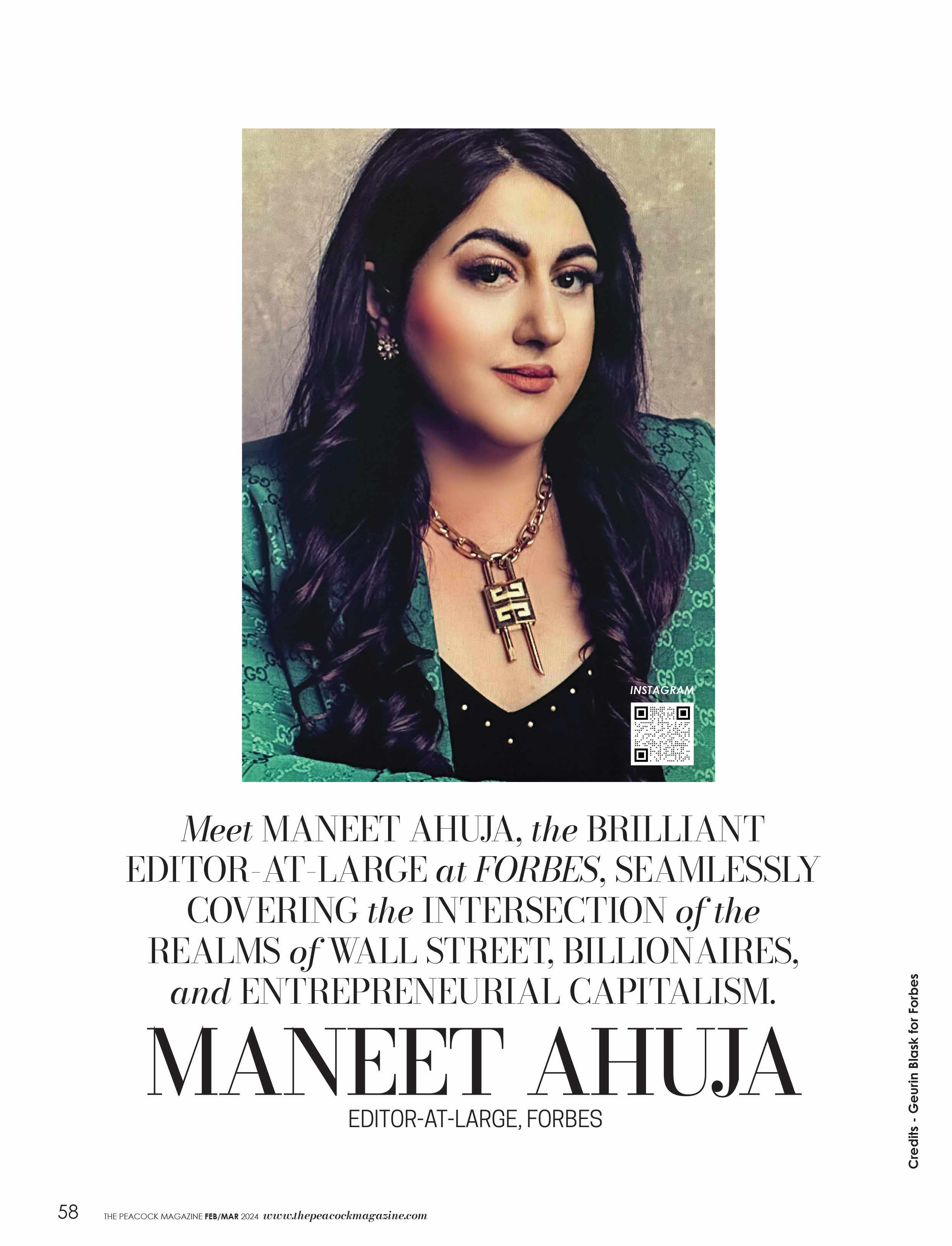
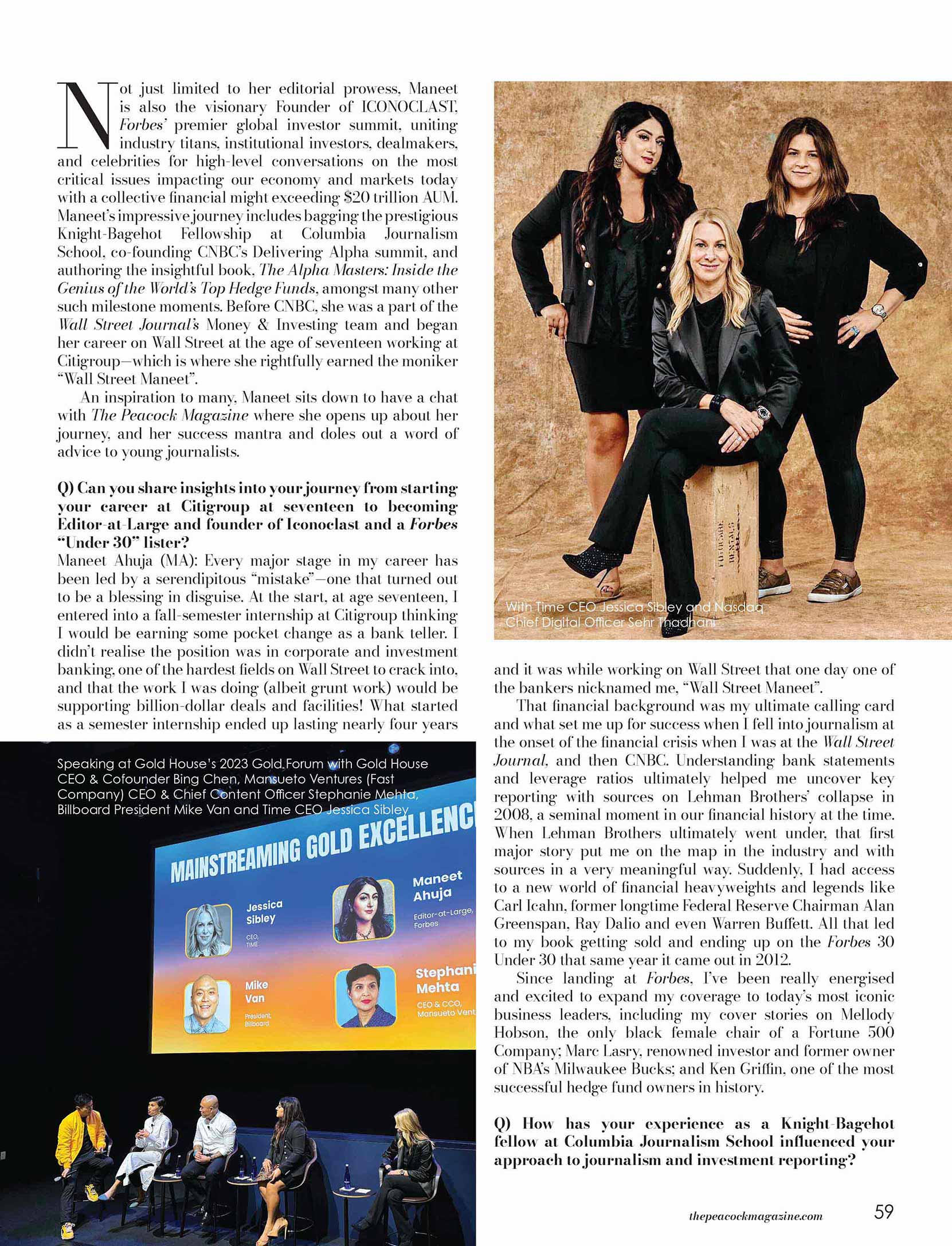
CREDITS – All images sourced from Maneet Ahuja
Meet Maneet Ahuja, the brilliant Editor-at-Large at Forbes, seamlessly covering the intersection of the realms of Wall Street, billionaires, and entrepreneurial capitalism.
Not just limited to her editorial prowess, Maneet is also the visionary Founder of ICONOCLAST, Forbes’ premier global investor summit, uniting industry titans, institutional investors, dealmakers, and celebrities for high-level conversations on the most critical issues impacting our economy and markets today with a collective financial might exceeding $20 trillion AUM. Maneet’s impressive journey includes bagging the prestigious Knight-Bagehot Fellowship at Columbia Journalism School, co-founding CNBC’s Delivering Alpha summit, and authoring the insightful book, The Alpha Masters: Inside the Genius of the World’s Top Hedge Funds, amongst many other such milestone moments. Before CNBC, she was a part of the Wall Street Journal’s Money & Investing team and began her career on Wall Street at the age of seventeen working at Citigroup—which is where she rightfully earned the moniker “Wall Street Maneet”.
An inspiration to many, Maneet sits down to have a chat with The Peacock Magazine where she opens up about her journey, and her success mantra and doles out a word of advice to young journalists.
Q) Can you share insights into your journey from starting your career at Citigroup at seventeen to becoming Editor-at-Large and founder of Iconoclast and a Forbes “Under 30” lister?
Every major stage in my career has been led by a serendipitous “mistake”—one that turned out to be a blessing in disguise. At the start, at age seventeen, I entered into a fall-semester internship at Citigroup thinking I would be earning some pocket change as a bank teller. I didn’t realise the position was in corporate and investment banking, one of the hardest fields on Wall Street to crack into, and that the work I was doing (albeit grunt work) would be supporting billion-dollar deals and facilities! What started as a semester internship ended up lasting nearly four years and it was while working on Wall Street that one day one of the bankers nicknamed me, “Wall Street Maneet”.
That financial background was my ultimate calling card and what set me up for success when I fell into journalism at the onset of the financial crisis when I was at the Wall Street Journal, and then CNBC. Understanding bank statements and leverage ratios ultimately helped me uncover key reporting with sources on Lehman Brothers’ collapse in 2008, a seminal moment in our financial history at the time. When Lehman Brothers ultimately went under, that first major story put me on the map in the industry and with sources in a very meaningful way. Suddenly, I had access to a new world of financial heavyweights and legends like Carl Icahn, former longtime Federal Reserve Chairman Alan Greenspan, Ray Dalio and even Warren Buffett. All that led to my book getting sold and ending up on the Forbes 30 Under 30 that same year it came out in 2012.
Since landing at Forbes, I’ve been really energised and excited to expand my coverage to today’s most iconic business leaders, including my cover stories on Mellody Hobson, the only black female chair of a Fortune 500 Company; Marc Lasry, renowned investor and former owner of NBA’s Milwaukee Bucks; and Ken Griffin, one of the most successful hedge fund owners in history.
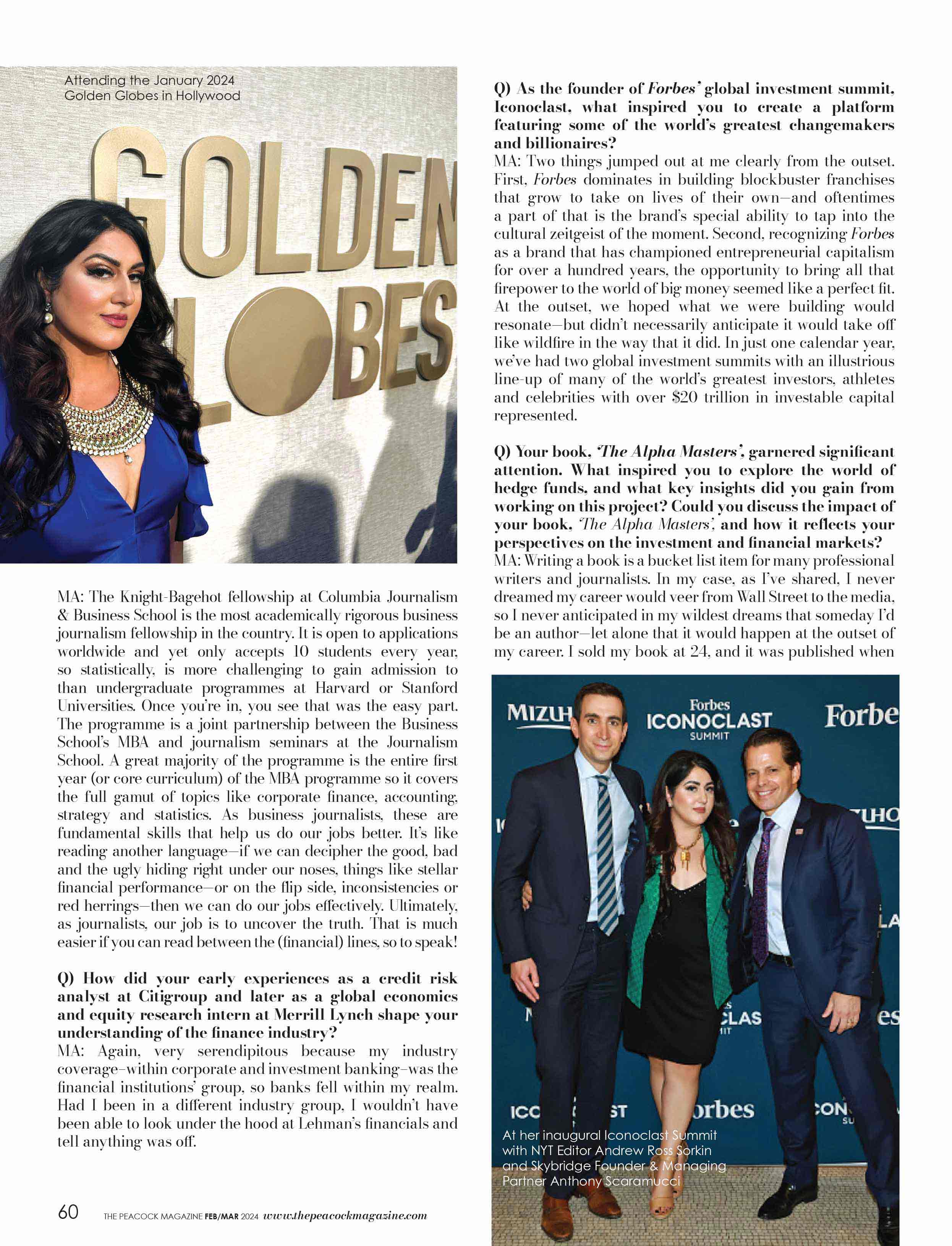
Q) How has your experience as a Knight-Bagehot fellow at Columbia Journalism School influenced your approach to journalism and investment reporting?
The Knight-Bagehot fellowship at Columbia Journalism & Business School is the most academically rigorous business journalism fellowship in the country. It is open to applications worldwide and yet only accepts 10 students every year, so statistically, is more challenging to gain admission to than undergraduate programmes at Harvard or Stanford Universities. Once you’re in, you see that was the easy part. The programme is a joint partnership between the Business School’s MBA and journalism seminars at the Journalism School. A great majority of the programme is the entire first year (or core curriculum) of the MBA programme so it covers the full gamut of topics like corporate finance, accounting, strategy and statistics. As business journalists, these are fundamental skills that help us do our jobs better. It’s like reading another language—if we can decipher the good, bad and the ugly hiding right under our noses, things like stellar financial performance—or on the flip side, inconsistencies or red herrings—then we can do our jobs effectively. Ultimately, as journalists, our job is to uncover the truth. That is much easier if you can read between the (financial) lines, so to speak!
Q) How did your early experiences as a credit risk analyst at Citigroup and later as a global economics and equity research intern at Merrill Lynch shape your understanding of the finance industry?
Again, very serendipitous because my industry coverage–within corporate and investment banking–was the financial institutions’ group, so banks fell within my realm. Had I been in a different industry group, I wouldn’t have been able to look under the hood at Lehman’s financials and tell anything was off.
Q) As the founder of Forbes’ global investment summit, Iconoclast, what inspired you to create a platform featuring some of the world’s greatest changemakers and billionaires?
Two things jumped out at me clearly from the outset. First, Forbes dominates in building blockbuster franchises that grow to take on lives of their own—and oftentimes a part of that is the brand’s special ability to tap into the cultural zeitgeist of the moment. Second, recognizing Forbes as a brand that has championed entrepreneurial capitalism for over a hundred years, the opportunity to bring all that firepower to the world of big money seemed like a perfect fit.
At the outset, we hoped what we were building would resonate—but didn’t necessarily anticipate it would take off like wildfire in the way that it did. In just one calendar year, we’ve had two global investment summits with an illustrious line-up of many of the world’s greatest investors, athletes and celebrities with over $20 trillion in investable capital represented.
Q) Your book, ‘The Alpha Masters’, garnered significant attention. What inspired you to explore the world of hedge funds, and what key insights did you gain from working on this project? Could you discuss the impact of your book, ‘The Alpha Masters’, and how it reflects your perspectives on the investment and financial markets?
Writing a book is a bucket list item for many professional writers and journalists. In my case, as I’ve shared, I never dreamed my career would veer from Wall Street to the media, so I never anticipated in my wildest dreams that someday I’d be an author—let alone that it would happen at the outset of my career. I sold my book at 24, and it was published when I was 27. The main reason for that was due to the financial crisis and a seminal moment that prompted a very influential crop of secretive, highly successful billionaire investors to suddenly start speaking to the press. I was fortunately the beneficiary of that and had a wealth of incredible stories just waiting to be told.
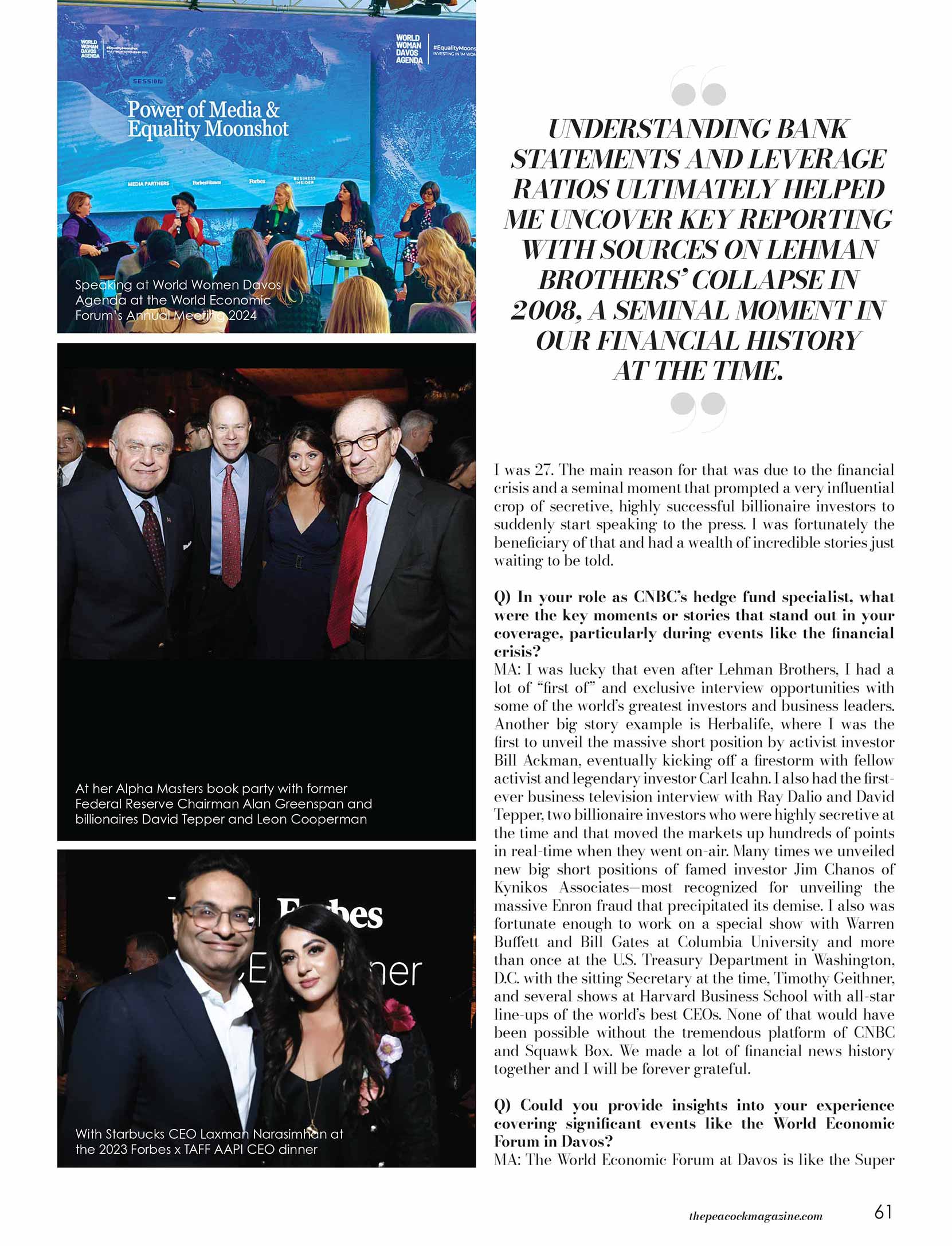
Q) In your role as CNBC’s hedge fund specialist, what were the key moments or stories that stand out in your coverage, particularly during events like the financial crisis?
I was lucky that even after Lehman Brothers, I had a lot of “first of” and exclusive interview opportunities with some of the world’s greatest investors and business leaders. Another big story example is Herbalife, where I was the first to unveil the massive short position by activist investor Bill Ackman, eventually kicking off a firestorm with fellow activist and legendary investor Carl Icahn. I also had the first-ever business television interview with Ray Dalio and David Tepper, two billionaire investors who were highly secretive at the time and that moved the markets up hundreds of points in real-time when they went on-air. Many times we unveiled new big short positions of famed investor Jim Chanos of Kynikos Associates—most recognized for unveiling the massive Enron fraud that precipitated its demise. I also was fortunate enough to work on a special show with Warren Buffett and Bill Gates at Columbia University and more than once at the U.S. Treasury Department in Washington, D.C. with the sitting Secretary at the time, Timothy Geithner, and several shows at Harvard Business School with all-star line-ups of the world’s best CEOs. None of that would have been possible without the tremendous platform of CNBC and Squawk Box. We made a lot of financial news history together and I will be forever grateful.
Q) Could you provide insights into your experience covering significant events like the World Economic Forum in Davos?
The World Economic Forum at Davos is like the Super Bowl for the global business and geopolitical community. Just being present is a huge moment for any business journalist, let alone covering the summit and all the key takeaways from a high-level perspective. This year’s theme was “Rebuilding Trust,” aptly fitting for the global crisis we find ourselves in at the moment. From a business perspective, I was fortunate to lead as a moderator and take part as a panellist in several conversations ranging from Big tech as a disruptor for the future of healthcare to the power of media and Equality Moonshots. The only consistent theme through all these conversations was a cautious outlook on AI and apprehension regarding how to put proper governance structures in place.

Q) Given your nickname ‘Wall Street Maneet’, how do you see the intersection between journalism and your early career experiences in finance at Citigroup?
The two were intrinsically intertwined. Had I not been covering banks while working at the bank (Citigroup), I would have never helped to tell the story of the collapse of Lehman Brothers. Without that huge story as the wind beneath my wings, so to speak, I would have never had a calling card to some of the world’s greatest investors in the early days of my career. Respect is earned, not given, and by working on such a tremendous story, I was fortunate to have earned their respect, I imagine.
Q) With your extensive career in journalism and finance, what advice would you offer to aspiring journalists, particularly those interested in covering the intersection of business, finance, and technology?
The best advice I can give to an aspiring journalist is to try to find the most exciting but underappreciated sub-sector or sub-culture within your industry or beat, and do your best to make yourself an expert in that vertical. You will develop unique sources and insights and will have less competition versus jumping into heavily covered industries like big tech or sports. Just think, all of today’s most popular fields from social media to AI to fintech and cryptocurrency were nascent just a few years ago. Find the next big thing by digging where no one else is looking.
Q) With your vast experience, how do you foresee the future landscape of financial journalism, especially in the context of emerging trends and technologies?
What’s most exciting about being a business journalist is that at its core, every story is a business story. A founder’s journey from solopreneur to unicorn status, a corporate rebrand, expansion or restructuring, a founder/CEO achieving billionaire status. Our U.S. political landscape has endless business angles whether it is which big billionaire donors are supporting which candidates or which industries or corporations are poised to thrive depending on party success—all roads lead back to the famous saying “follow the money”. So for me, the future landscape of financial journalism will always shift in tandem with how the world is ever-evolving. Right now, it’s all about artificial intelligence and how it is already being adopted and will disrupt every industry and global economy. There are endless potential positive outcomes but equally so, potential negative consequences as well. It’s our job as business journalists to make sure to do our best to thoroughly report on both aspects equally.
Q) By now, you’ve practically done it all. Do you think that your hunger for knowledge will ever be satiated?
I’ve hardly done it all. From my point of view, I’ve encountered a lot of hardships like everyone else—and have barely scratched the surface. I think family and friends are grounding. I hope I am never satiated. I believe when we are no longer learning it is hardly a life at all. And especially so, once you lose that intellectual curiosity as a journalist, you’ve lost your compass, your North Star. An insatiable thirst for knowledge is the greatest gift of all.
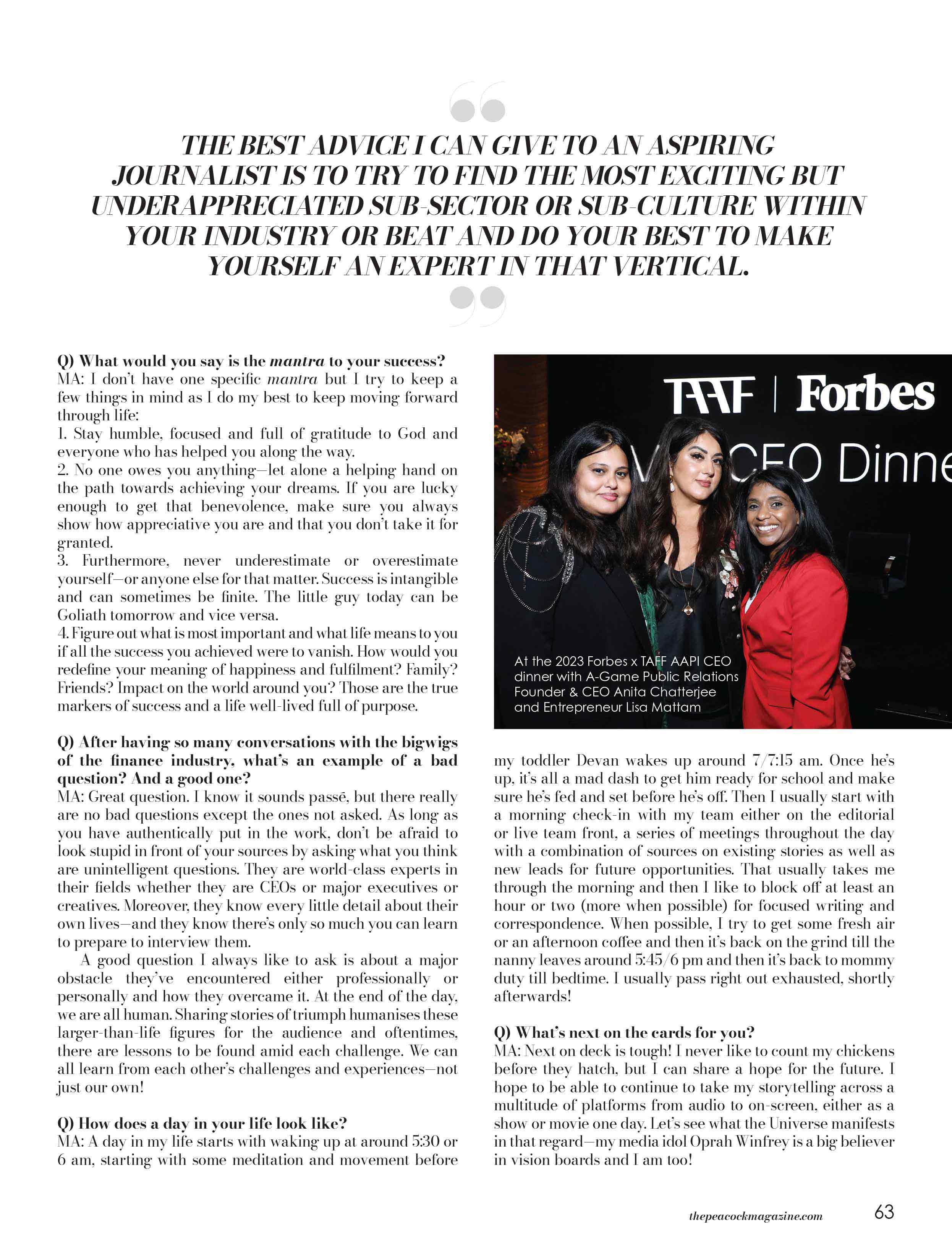
Q) What would you say is the mantra to your success?
I don’t have one specific mantra but I try to keep a few things in mind as I do my best to keep moving forward through life:
- 1. Stay humble, focused and full of gratitude to God and everyone who has helped you along the way.
- 2. No one owes you anything—let alone a helping hand on the path towards achieving your dreams. If you are lucky enough to get that benevolence, make sure you always show how appreciative you are and that you don’t take it for granted.
- 3. Furthermore, never underestimate or overestimate yourself—or anyone else for that matter. Success is intangible and can sometimes be finite. The little guy today can be Goliath tomorrow and vice versa.
- 4. Figure out what is most important and what life means to you if all the success you achieved were to vanish. How would you redefine your meaning of happiness and fulfilment? Family? Friends? Impact on the world around you? Those are the true markers of success and a life well-lived full of purpose.
Q) After having so many conversations with the bigwigs of the finance industry, what’s an example of a bad question? And a good one?
Great question. I know it sounds passé, but there really are no bad questions except the ones not asked. As long as you have authentically put in the work, don’t be afraid to look stupid in front of your sources by asking what you think are unintelligent questions. They are world-class experts in their fields whether they are CEOs or major executives or creatives. Moreover, they know every little detail about their own lives—and they know there’s only so much you can learn to prepare to interview them.
A good question I always like to ask is about a major obstacle they’ve encountered either professionally or personally and how they overcame it. At the end of the day, we are all human. Sharing stories of triumph humanises these larger-than-life figures for the audience and oftentimes, there are lessons to be found amid each challenge. We can all learn from each other’s challenges and experiences—not just our own!
Q) How does a day in your life look like?
A day in my life starts with waking up at around 5:30 or 6 am, starting with some meditation and movement before my toddler Devan wakes up around 7/7:15 am. Once he’s up, it’s all a mad dash to get him ready for school and make sure he’s fed and set before he’s off. Then I usually start with a morning check-in with my team either on the editorial or live team front, a series of meetings throughout the day with a combination of sources on existing stories as well as new leads for future opportunities. That usually takes me through the morning and then I like to block off at least an hour or two (more when possible) for focused writing and correspondence. When possible, I try to get some fresh air or an afternoon coffee and then it’s back on the grind till the nanny leaves around 5:45/6 pm and then it’s back to mommy duty till bedtime. I usually pass right out exhausted, shortly afterwards!
Q) What’s next on the cards for you?
Next on deck is tough! I never like to count my chickens before they hatch, but I can share a hope for the future. I hope to be able to continue to take my storytelling across a multitude of platforms from audio to on-screen, either as a show or movie one day. Let’s see what the Universe manifests in that regard—my media idol Oprah Winfrey is a big believer in vision boards and I am too!
